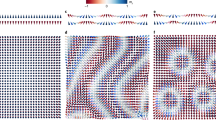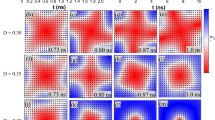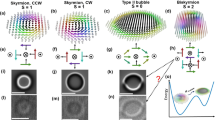Abstract
Magnetic skyrmions are topological solitons with a nanoscale winding spin texture that hold promise for spintronics applications1,2,3,4. Skyrmions have so far been observed in a variety of magnets that exhibit nearly parallel alignment for neighbouring spins, but theoretically skyrmions with anti-parallel neighbouring spins are also possible. Such antiferromagnetic skyrmions may allow more flexible control than conventional ferromagnetic skyrmions5,6,7,8,9,10. Here, by combining neutron scattering measurements and Monte Carlo simulations, we show that a fractional antiferromagnetic skyrmion lattice is stabilized in MnSc2S4 through anisotropic couplings. The observed lattice is composed of three antiferromagnetically coupled sublattices, and each sublattice is a triangular skyrmion lattice that is fractionalized into two parts with an incipient meron (half-skyrmion) character11,12. Our work demonstrates that the theoretically proposed antiferromagnetic skyrmions can be stabilized in real materials and represents an important step towards their implementation in spintronic devices.
This is a preview of subscription content, access via your institution
Access options
Access Nature and 54 other Nature Portfolio journals
Get Nature+, our best-value online-access subscription
$29.99 / 30 days
cancel any time
Subscribe to this journal
Receive 51 print issues and online access
$199.00 per year
only $3.90 per issue
Buy this article
- Purchase on Springer Link
- Instant access to full article PDF
Prices may be subject to local taxes which are calculated during checkout




Similar content being viewed by others
Data availability
The data that support the findings of this study are available at https://doi.org/10.5281/zenodo.3902757 and from the corresponding author upon reasonable request.
Code availability
The codes for the spin-wave calculations and the Monte Carlo simulations that support the findings of this study are available from the corresponding author upon reasonable request.
Change history
08 October 2020
This Article was amended to correct the Peer review information in the Additional information section.
References
Mühlbauer, S. et al. Skyrmion lattice in a chiral magnet. Science 323, 915–919 (2009).
Yu, X. Z. et al. Real-space observation of a two-dimensional skyrmion crystal. Nature 465, 901–904 (2010).
Nagaosa, N. & Tokura, Y. Topological properties and dynamics of magnetic skyrmions. Nat. Nanotechnol. 8, 899–911 (2013).
Fert, A., Reyren, N. & Cros, V. Magnetic skyrmions: advances in physics and potential applications. Nat. Rev. Mater. 2, 17031 (2017).
Baltz, V. et al. Antiferromagnetic spintronics. Rev. Mod. Phys. 90, 015005 (2018).
Barker, J. & Tretiakov, O. A. Static and dynamical properties of antiferromagnetic skyrmions in the presence of applied current and temperature. Phys. Rev. Lett. 116, 147203 (2016).
Zhang, X., Zhou, Y. & Ezawa, M. Antiferromagnetic skyrmion: stability, creation and manipulation. Sci. Rep. 6, 24795 (2016).
Rosales, H. D., Cabra, D. C. & Pujol, P. Three-sublattice skyrmion crystal in the antiferromagnetic triangular lattice. Phys. Rev. B 92, 214439 (2015).
Díaz, S. A., Klinovaja, J. & Loss, D. Topological magnons and edge states in antiferromagnetic skyrmion crystals. Phys. Rev. Lett. 122, 187203 (2019).
Kamiya, Y. & Batista, C. D. Magnetic vortex crystals in frustrated Mott insulator. Phys. Rev. X 4, 011023 (2014).
Lin, S.-Z., Saxena, A. & Batista, C. D. Skyrmion fractionalization and merons in chiral magnets with easy-plane anisotropy. Phys. Rev. B 91, 224407 (2015).
Yu, X. Z. et al. Transformation between meron and skyrmion topological spin textures in a chiral magnet. Nature 564, 95–98 (2018).
Wen, X.-G. Zoo of quantum-topological phases of matter. Rev. Mod. Phys. 89, 041004 (2017).
Jonietz, F. et al. Spin transfer torques in MnSi at ultralow current densities. Science 330, 1648–1651 (2010).
Yu, X. et al. Skyrmion ow near room temperature in an ultralow current density. Nat. Commun. 3, 988 (2012).
White, J. S. et al. Electric field control of the skyrmion lattice in Cu2OSeO3. J. Phys. Condens. Matter 24, 432201 (2012).
Rößler, U. K., Bogdanov, A. N. & Peiderer, C. Spontaneous skyrmion ground states in magnetic metals. Nature 442, 797–801 (2006).
Kurumaji, T. et al. Skyrmion lattice with a giant topological Hall effect in a frustrated triangular-lattice magnet. Science 365, 914–918 (2019).
Hirschberger, M. et al. Skyrmion phase and competing magnetic orders on a breathing kagomé lattice. Nat. Commun. 10, 5831 (2019).
Khanh, N. D. et al. Nanometric square skyrmion lattice in a centrosymmetric tetragonal magnet. Nat. Nanotechnol. 15, 444–449 (2020).
Sokolov, D. A. et al. Metamagnetic texture in a polar antiferromagnet. Nat. Phys. 15, 671–677 (2019).
Balents, L. Spin liquids in frustrated magnets. Nature 464, 199–208 (2010).
Okubo, T., Chung, S. & Kawamura, H. Multiple-q states and the skyrmion lattice of the triangular-lattice Heisenberg antiferromagnet under magnetic fields. Phys. Rev. Lett. 108, 017206 (2012).
Leonov, A. O. & Mostovoy, M. Multiply periodic states and isolated skyrmions in an anisotropic frustrated magnet. Nat. Commun. 6, 8275 (2015).
Sutcliffe, P. Skyrmion knots in frustrated magnets. Phys. Rev. Lett. 118, 247203 (2017).
Rybakov, F. N. et al. Magnetic hopfions in solids. Preprint at https://arxiv.org/abs/1904.00250 (2019).
Lohani, V., Hickey, C., Masell, J. & Rosch, A. Quantum skyrmions in frustrated ferromagnets. Phys. Rev. X 9, 041063 (2019).
Fritsch, V. et al. Spin and orbital frustration in MnSc2S4 and FeSc2S4. Phys. Rev. Lett. 92, 116401 (2004).
Gao, S. et al. Spiral spin-liquid and the emergence of a vortex-like state in MnSc2S4. Nat. Phys. 13, 157–161 (2017).
Bergman, D., Alicea, J., Gull, E., Trebst, S. & Balents, L. Order-by-disorder and spiral spin liquid in frustrated diamond-lattice antiferromagnets. Nat. Phys. 3, 487–491 (2007).
Lee, S. & Balents, L. Theory of the ordered phase in A-site antiferromagnetic spinels. Phys. Rev. B 78, 144417 (2008).
Iqbal, Y., Müller, T., Jeschke, H. O., Thomale, R. & Reuther, J. Stability of the spiral spin liquid in MnSc2S4. Phys. Rev. B 98, 064427 (2018).
Zaharko, O. et al. Spin liquid in a single crystal of the frustrated diamond lattice antiferromagnet CoAl2O4. Phys. Rev. B 84, 094403 (2011).
MacDougall, G. J. et al. Revisiting the ground state of CoAl2O4: comparison to the conventional antiferromagnet MnAl2O4. Phys. Rev. B 94, 184422 (2016).
Ge, L. et al. Spin order and dynamics in the diamond-lattice Heisenberg antiferromagnets CuRh2O4 and CoRh2O4. Phys. Rev. B 96, 064413 (2017).
Watanabe, H. On the ground level splitting of Mn++ and Fe+++ in nearly cubic crystalline field. Prog. Theor. Phys. 18, 405–420 (1957).
Akagi, Y., Udagawa, M. & Motome, Y. Hidden multiple-spin interactions as an origin of spin scalar chiral order in frustrated Kondo lattice models. Phys. Rev. Lett. 108, 096401 (2012).
Hayami, S., Ozawa, R. & Motome, Y. Effective bilinear–biquadratic model for noncoplanar ordering in itinerant magnets. Phys. Rev. B 95, 224424 (2017).
Milde, P. et al. Unwinding of a skyrmion lattice by magnetic monopoles. Science 340, 1076–1080 (2013).
Karube, K. et al. Robust metastable skyrmions and their triangular-square lattice structural transition in a high-temperature chiral magnet. Nat. Mater. 15, 1237–1242 (2016).
Attig, J. & Trebst, S. Classical spin spirals in frustrated magnets from free-fermion band topology. Phys. Rev. B 96, 085145 (2017).
Balla, P., Iqbal, Y. & Penc, K. Affine lattice construction of spiral surfaces in frustrated Heisenberg models. Phys. Rev. B 100, 140402 (2019).
Göbel, B., Mook, A., Henk, J. & Mertig, I. Antiferromagnetic skyrmion crystals: generation, topological Hall, and topological spin Hall effect. Phys. Rev. B 96, 060406 (2017).
Bessarab, P. F. et al. Stability and lifetime of antiferromagnetic skyrmions. Phys. Rev. B 99, 140411 (2019).
van Hoogdalem, K. A., Tserkovnyak, Y. & Loss, D. Magnetic texture-induced thermal Hall effects. Phys. Rev. B 87, 024402 (2013).
Daniels, M. W., Yu, W., Cheng, R., Xiao, J. & Xiao, D. Topological spin Hall effects and tunable skyrmion Hall effects in uniaxial antiferromagnetic insulators. Phys. Rev. B 99, 224433 (2019).
Roldán-Molina, A., Nunez, A. S. & Fernández-Rossier, J. Topological spin waves in the atomic-scale magnetic skyrmion crystal. New J. Phys. 18, 045015 (2016).
Krimmel, A. et al. Magnetic ordering and spin excitations in the frustrated magnet MnSc2S4. Phys. Rev. B 73, 014413 (2006).
Boehm, M. et al. ThALES—three axis low energy spectroscopy for highly correlated electron systems. Neutron News 26, 18–21 (2015).
Zaharko, O. et al. Spin dynamics in the order-by-disorder candidate MnSc2S4. Report https://doi.org/10.5291/ILL-DATA.4-01-1500 (Institut Laue-Langevin, 2016).
Schneidewind, A. & Čermák, P. PANDA: cold three axes spectrometer. J. Large-Scale Res. Facilities 1, A12 (2015).
Utschick, C., Skoulatos, M., Schneidewind, A. & Böni, P. Optimizing the triple-axis spectrometer PANDA at the MLZ for small samples and complex sample environment conditions. Nucl. Instr. Meth. Phys. Res. A 837, 88–91 (2016).
Toth, S. & Lake, B. Linear spin wave theory for single-Q incommensurate magnetic structures. J. Phys. Condens. Matter 27, 166002 (2015).
Johnston, D. C. et al. Magnetic exchange interactions in BaMn2As2: a case study of the J 1-J 2-J c Heisenberg model. Phys. Rev. B 84, 094445 (2011).
Kézsmárki, I. et al. Néel type skyrmion lattice with confined orientation in the polar magnetic semiconductor GaV4S8. Nat. Mater. 14, 1116–1122 (2015).
Acknowledgements
We acknowledge S. Tóth and S. Ward for help in the analysis of the neutron spectra. We thank A. Scaramucci for the initial trial of the Monte Carlo simulations. We acknowledge discussions with M. Pregelj, S. B. Lee, T.-h. Arima, T. Nakajima, J. S. White and Y. Su. S.G. acknowledges discussions at RIKEN CEMS. F.A.G.A. and H.D.R thank R. Borzi for discussions. H.D.R. thanks M. Zhitomirsky for discussions about the Monte Carlo simulations. Our neutron scattering experiments were performed at the SINQ, PSI, Villigen, Switzerland, at MLZ, Garching, Germany and at ILL, Grenoble, France. This work was supported by the Swiss National Science Foundation under grant numbers 20021-140862 and 20020-152734, by the SCOPES project number IZ73Z0-152734/1 and by Centro Latinoamericano-Suizo under the Seed money grant number SMG1811. Our work was additionally supported by Deutsche Forschungsgemeinschaft of the Transregional Collaborative Research Center TRR 80. D.C.C., F.A.G.A. and H.D.R. are partially supported by CONICET (PIP 2015-813), SECyT UNLP PI+D X792 and X788, PPID X039. H.D.R. acknowledges support from PICT 2016-4083.
Author information
Authors and Affiliations
Contributions
O.Z. designed and coordinated the project. V.T. prepared the single crystals. S.G., O.Z. and C.R. performed the INS experiments with T.F. as the local contact for FOCUS, P.S. and M.B. for ThALES and P.C. and A.S. for PANDA. S.G. analysed the neutron spectra with input from O.Z., T.F. and C.R. Neutron diffraction experiments were performed by G.K. and O.Z, with E.R. as the local contact. Theoretical analysis and Monte Carlo simulations were performed by H.D.R., F.A.G.A. and D.C.C. The manuscript was prepared by S.G., H.D.R. and O.Z. with input from all co-authors.
Corresponding author
Ethics declarations
Competing interests
The authors declare no competing interests.
Additional information
Peer review information Nature thanks Yoshitomo Kamiya and the other, anonymous, reviewer(s) for their contribution to the peer review of this work.
Publisher’s note Springer Nature remains neutral with regard to jurisdictional claims in published maps and institutional affiliations.
Extended data figures and tables
Extended Data Fig. 1 Comparison of different spin models.
a, INS spectra S(Q, ω) collected on FOCUS at T = 1.3 K using a powder sample of MnSc2S4. b–d, INS spectra calculated using the linear spin-wave theory for the J1–J2–J3 model with J1 = −0.31 K, J2 = 0.46 K and J3 = 0.087 K, as discussed in the main text (b), for the J1–J2 model with J1 = −0.71 K, J2 = −0.85 × J1 = 0.60 K (c), and for the J1–J2–J3 model with parameters calculated from the DFT calculations32, J1 = −0.378 K, J2 = 0.621 K and J3 = 0.217 K. Note the different energy ranges in different panels.
Extended Data Fig. 2 Spiral surface above the long-range order transition.
Spin correlations in the (hk0) plane calculated by Monte Carlo simulations using the J1–J2–J3 model and the anisotropic perturbation terms with coupling strength listed in the main text. Calculations were performed at T = 2.9 K. Calculations with zero anisotropic perturbations do not affect the results.
Extended Data Fig. 3 Calculated phase diagram with perturbations J|| = −0.01 K and A4 = 0.0016 K.
Phase diagram for MnSc2S4 obtained from Monte Carlo simulations with a field applied along the [111] direction as in the experiment. The colour map shows the calculated absolute value of the total scalar spin chirality, χtot. Squares indicate the phase boundary obtained from the peak position of the calculated magnetic susceptibility in field along the [111] direction. Up-pointing triangles on the boundary of the antiferromagnetic skyrmion lattice (AF-SkL) phase are the middle points of the steep rise/drop in χtot as a function of magnetic field at constant T, and their errors are estimated using the half-width of the transitional region. Left-pointing triangles mark the sudden rise in χtot(T) in constant field. Error bars representing the standard deviations are not shown if their length is smaller than the marker size.
Extended Data Fig. 4 Identifying the triple-q phase.
Magnetic structure factor obtained by simulations in the triple-q phase at T = 1.25 K and B111 = 5.6 T in the (hk0) (a) and (111) (b) planes.
Extended Data Fig. 5 Dependence of the triple-q phase stability on the perturbation terms J||.
a–d, Calculated phase diagrams with perturbations J|| = 0.01 K (a), −0.005 K (b), −0.01 K (c) and −0.02 K (d). The single-ion anisotropy A4 is fixed at 0.0016 K. The colour map shows the absolute value of the total scalar spin chirality as in Extended Data Fig. 3. e–h, Field dependence of the domain population at T = 0.1 K. Red circles and blue triangles indicate domains with q in and out of the (111) plane, respectively. Yellow squares are the calculated absolute values of the scalar spin chirality. Error bars representing the standard deviations of the mean are smaller than the marker size.
Extended Data Fig. 6 Analytical ansatz for the antiferromagnetic skyrmion lattice.
a, Schematic for the moment directions in each q component of the triple-q structure at ϕ111 = −π (helical), −3π/2 (collinear) and −9π/8 (distorted helical). b, Comparison between the representative magnetic texture for one sublattice in the (111) plane obtained by the analytical ansatz (left) and Monte Carlo simulations (right) performed at T = 0.5 K and B111 = 5 T. The colour scheme indicates the spin component along the [111] direction, and the arrows show the spin component in the (111) plane.
Extended Data Fig. 7 Refinement of the neutron diffraction dataset collected in the triple-q phase.
a, Comparison of observed and calculated intensities for the fractional antiferromagnetic skyrmion lattice. The dataset was collected in the triple-q phase under a magnetic field of 3.5 T along the [111] direction. b, Dependence of the RF2 factor on the phase factor ϕ111. The arrows indicate results for ϕ111 = −π, −3π/2 and −9π/8, which correspond to the triple-q structures with helical, collinear and distorted helical components, respectively. The error bars correspond to the standard deviations of the measured neutron intensities (a) and the refined phase factor (b). c, Magnetic textures for one sublattice in the (111) plane with ϕ111 = −9π/8, −π and −7π/8, showing that in the region −9π/8 ≤ ϕ111 ≤ −7π/8 the triple-q structure always realizes a fractional antiferromagnetic skyrmion lattice, and only the proportion of fractionalization is varied. The colour scheme indicates the spin component along the [111] direction, and the arrows show the spin component in the (111) plane.
Rights and permissions
About this article
Cite this article
Gao, S., Rosales, H.D., Gómez Albarracín, F.A. et al. Fractional antiferromagnetic skyrmion lattice induced by anisotropic couplings. Nature 586, 37–41 (2020). https://doi.org/10.1038/s41586-020-2716-8
Received:
Accepted:
Published:
Issue Date:
DOI: https://doi.org/10.1038/s41586-020-2716-8
This article is cited by
-
Spatially reconfigurable antiferromagnetic states in topologically rich free-standing nanomembranes
Nature Materials (2024)
-
Magnon thermal Hall effect via emergent SU(3) flux on the antiferromagnetic skyrmion lattice
Nature Communications (2024)
-
Controllable nucleation and deformation of skyrmions on surface of magnetic nanotubular monolayer
Rare Metals (2024)
-
Topology-induced chiral photon emission from a large-scale meron lattice
Nature Electronics (2023)
-
Antiferromagnetic half-skyrmions electrically generated and controlled at room temperature
Nature Nanotechnology (2023)
Comments
By submitting a comment you agree to abide by our Terms and Community Guidelines. If you find something abusive or that does not comply with our terms or guidelines please flag it as inappropriate.



